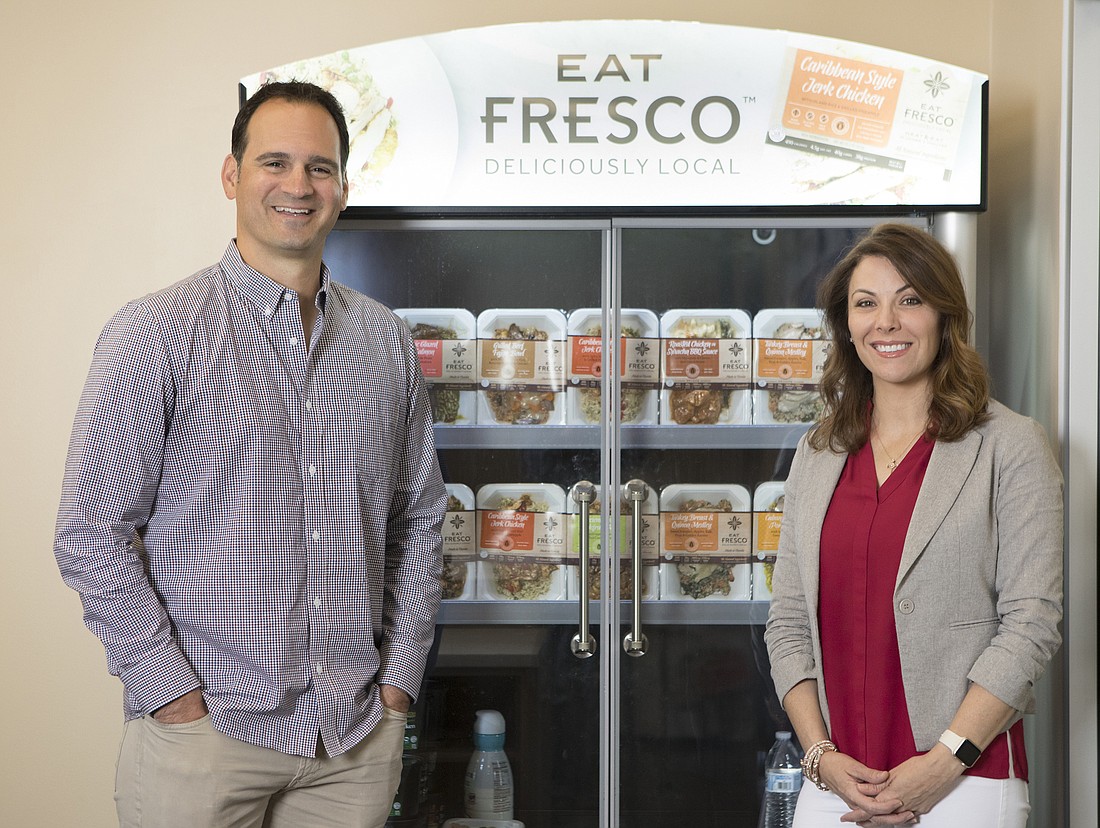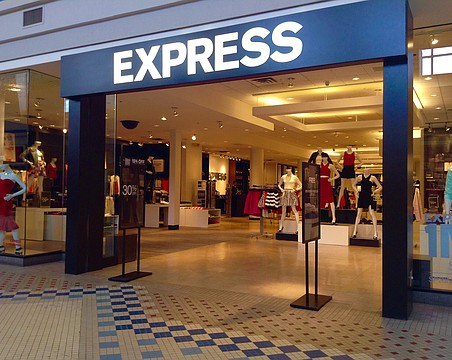For Rob and Tracy Povolny, everything was going to plan as they entered their mid-30s.
Rob had a solid corporate America career track, enjoying stops at Coca-Cola and Nestlé before landing at Chicago-based Griffith Foods, an ingredients company serving food makers all over the world. Tracy, meanwhile, worked for Pretty City, a marketing firm for health, wellness and beauty brands, and also dabbled in retail management before opening her own tanning salon.
The bottom dropped out in 2014, when Griffith eliminated Rob’s position.
But the couple quickly turned a stumble into an opportunity to expand their entrepreneurial mindset. They co-founded Fresco Foods Inc., which makes the Eat Fresco line of vacuum-sealed, nonfrozen, prepared meals sold in 300 grocery stores around Florida, including about 20% of Publix supermarkets in the state.
The Povolnys want to make that 100%, but that’s not all: They also seek more capital that will allow them to open Eat Fresco production facilities on the U.S. East Coast, which would expand their reach to a multitude of lucrative new markets.
“We have a model that we’ve proved out,” Rob Povolny says, “and now we’re ready to pour gasoline on the fire.”
Standing in their way is scale. It’s one thing to succeed on a regional level, but it's quite another to become a national brand. How will they do it? The journey starts with telling their story to the finance world. And it includes using new ways to handle everything the business does, from marketing to logistics.
Power of an idea
The launch of Eat Fresco came about somewhat naturally.
“I had a passion for entrepreneurship,” says Tracy Povolny, 43, who completed her degree in business management at the University of South Florida around the time that Rob, 42, lost his job.
It was Tracy, the couple says, who sparked the idea of launching a food manufacturing company based around convenient but also fresh, healthy and affordable meals. As a marketer plugged into trends like home-delivered meal kits and Uber Eats, she knew demand was moving away from “TV dinners” and other mass-produced frozen products.
“I envisioned a drive-thru that would offer really healthy food that you could just pick up quickly,” she says. “It was convenient but would have had healthier offerings.”
“If you put food on a tray with a lid on it, it’s good for two to five days — five is pushing it. It’s really tough to go to retail with that kind of short shelf life.” Rob Povolny, president of Fresco Foods Inc.
That concept didn’t get off the ground, but it led her and Rob to discuss a different, more scalable business model — prepackaged meals, sold at the retail level, that would be prepared fresh and never frozen while retaining enough shelf life to meet the demands of grocers like Publix and enough nutritious value to satisfy shoppers looking for a higher-quality yet reasonably priced product.
It sounded, on paper, like an impossible challenge.
“We wanted to deliver something that wouldn’t require you to sacrifice,” Rob Povolny says. “Usually, if you want [a meal] quick and easy, you sacrifice something — whether it’s not that good for you or you have to spend $10, $12, even $14 for takeout.”
“Or it’s really healthy, but it doesn’t taste all that great,” Tracy Povolny adds.
Calling on Rob Povolny's background in food ingredients, the couple went to work. They rented space in a commercial kitchen to develop and test recipes and figure out a disruptive way to package products. They were bootstrapped and using funds from Rob’s severance package and loans from family members.
But the couple eventually reached a crossroads that kept them from going to market.
“We said, ‘We either have to find a co-packer,’ which a lot of food and beverage companies do, but we didn’t want to give up control,” says Rob Povolny, “‘or we have to self-produce’ — which meant we had to build our own facility.”
And that meant they needed capital — lots of it.
Armed with support from angel investors and a $1.5 million SBA loan from Sunshine Bank, which has since been bought by CenterState Bank, the Povolnys were able to acquire and develop a 13,000-square-foot space at 9410 E. Broadway Ave. East of downtown Tampa, the $2 million project is now where Eat Fresco products are prepared, packaged and shipped out.
“Sunshine took a really big risk, giving us a fairly large SBA loan to build a facility when we didn’t really have contracts in hand, per se,” Rob Povolny says. “But they said, ‘We’re in it for you — we see the vision.’”
The bank’s risk is about to pay off. Fresco Foods Inc. became profitable earlier this year, Povolny says, on the strength of revenue on track to be more than seven times higher than what the company did in 2018; he declines to disclose specific revenue figures. And with a weekly production run of 20,000 meals, the facility is operating at only one-third capacity.
As demand rises for Eat Fresco products, Rob expects to add a second shift of workers, likely by the end of the year. When the facility is operating at full capacity, he anticipates generating somewhere between $10 million and $20 million per year in gross annual revenue.
Package deal
A critical innovation that sets the Eat Fresco brand apart is the way its products are prepared and packaged. Fresh ingredients supplied by Cheney Brothers, a Riviera Beach-based distributor, are cooked and then plated by hand, like a chef would do in a restaurant. Then the meals are vacuum-sealed by a machine and put in small boxes stored in a cold room before being shipped out across the state. Options include balsamic glaze grilled salmon, grilled chicken fajita bowl and roasted chicken in sriracha BBQ sauce.
“If you put food on a tray with a lid on it, it’s good for two to five days — five is pushing it,” Rob Povolny says. “It’s really tough to go to retail with that kind of short shelf life. The vacuum packaging gives us over a two-week shelf life.”
It also separates Eat Fresco from the frozen-food pack. And because the technology requires the use of fewer materials, vacuum-sealed food costs less to package, Rob Povolny says. It’s just the tray, which can be recycled; the food; and the plastic sealant wrap. No cardboard box needed.
Where the technology gets tricky, though, is in getting the products into people's hands — and on their plates. “The logistics around fresh food are a lot more challenging,” Tracy Povolny says. “But it’s worth it because the experience is a lot different for the customer.”
"This is not your father’s frozen dinner," Rob Povolny adds.
He says that one reason people shy away from this model is because of time constraints. “With frozen, you can produce a bunch of inventory, put it in the freezer and ship it whenever sales come in," he says. "But ours, you have to make it every day. You have to get it out to stores every day. You have to make sure it sells.”
Marketing the product, at least initially, was a challenge, too. The couple's solution was to make sure they dealt with the right retail partners — chains including Earth Fare and Publix Greenwise Market — as well as local grocers, such as Rollin’ Oats in St. Petersburg and Duckweed Urban Grocery in Tampa. Shoppers who frequent those stores, he says, are usually willing to pay a few extra bucks — most Eat Fresco dishes are priced at $7.99 — for a higher-quality, nonfrozen, prepared meal.
Another key driver of sales? Allocating a significant chunk of the marketing budget toward on-site product demos and samples handed out at the retail level.
Think big
It's also not your father's funding strategy when it comes to expansion plans.
Fresco Foods has had some success at raising capital via two funding rounds that each produced less than $1 million, Rob Povolny says. But more is needed to further scale the business, and the couple is willing to get creative when it comes to attracting investment.
“One of the ideas we have is to develop a joint venture with an owner in, say, the northeast, Georgia or the Carolinas — wherever our next facility might be,” he says. “They would own an aspect of that market, so they’re invested in how it does. We’ll see about that. This is the year to figure that out.”
Their mission to propel the Eat Fresco brand upward begins in earnest in June, when they’ll exhibit at the International Dairy-Deli-Bakery Association trade show in Orlando. It’s a chance to get the concept in front of investors and buyers worldwide and “give us the dry powder we need to scale,” Rob Povolny says.
“We’re looking to meet with venture capitalists for a more institutional round of funding, maybe a VC group that’s helped a consumer products company grow and scale," he says. "We think we have a nice story to tell to those investors.”






